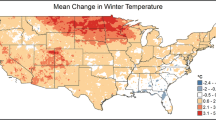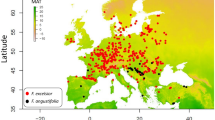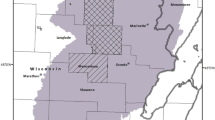Abstract
Native to Asia, the emerald ash borer (Agrilus planipennis Fairmaire) has caused extensive mortality of ash tree species (Fraxinus spp.) in the eastern United States. As of 2013, the pest was documented in 18 % of counties within the natural range of ash in the eastern United States. Regional forest inventory data from the U.S. Forest Service Forest Inventory and Analysis program were used to quantify trends in ash mortality rate and volume per hectare relative to the year of initial emerald ash borer detection. Results indicate that the annual ash mortality rate increases by as much as 2.7 % per year after initial detection of the pest in a county. Corresponding decreases in ash volume (as much as 1.8 m3 per hectare per year) continue for several more years until most live ash is killed. These results, while not necessarily representative of the effects on ash in urban ecosystems, document the severe impact this invading herbivore is having on forests as it expands its range in North America.




Similar content being viewed by others
References
Anulewicz AC, McCullough DG, Cappaert DL, Poland TM (2008) Host range of the emerald ash borer (Agrilus planipennis Fairmaire) (Coleoptera: Buprestidae) in North America: results of multiple-choice field experiments. Environ Entomol 37:230–241
Aukema JE, McCullough DG, Holle BV, Liebhold AM, Britton K, Frankel SJ (2010) Historical accumulation of nonindigenous forest pests in the continental United States. Bioscience 60:886–897
Aukema JE, Leung B, Kovacs K, Chivers C, Britton KO, Englin J et al (2011) Economic impacts of non-native forest insects in the continental United States. PLoS ONE 6:e24587
Bechtold WA, Patterson PL (eds) (2005) The enhanced forest inventory and analysis program—national sampling design and estimation procedures. USDA For. Serv. Gen. Tech. Rep. SRS-80
Bray AM, Bauer LS, Poland TM, Haack RA, Cognato AI, Smith JJ (2011) Genetic analysis of emerald ash borer (Agrilus planipennis Fairmaire) populations in Asia and North America. Biol Invasions 13:2869–2887
Burr SJ, McCullough DG (2014) Condition of green ash (Fraxinus pennsylvanica) overstory and regeneration at three stages of the emerald ash borer invasion wave. Can J For Res 44:768–776
Crooks JA (2005) Lag times and exotic species: the ecology and management of biological invasions in slow-motion. Ecoscience 12:316–329
Davidson CB, Gottschalk KW, Johnson JE (1999) Tree mortality following defoliation by the European gypsy moth (Lymantria dispar L.) in the United States: a review. For Sci 45:74–84
Duan JJ, Bauer LS, Abell KJ, Ulyshen MD, Van Driesche RG (2015) Population dynamics of an invasive forest insect and associated natural enemies in the aftermath of invasion: implications for biological control. J Appl Ecol 52:1246–1252
Flower CE, Knight KS, Gonzalez-Meler MA (2013) Impacts of the emerald ash borer (Agrilus planipennis) induced ash (Fraxinus spp.) mortality on forest carbon cycling and successional dynamics in the eastern United States. Biol Invasions 15:931–944
Gandhi KJ, Herms DA (2010a) Direct and indirect effects of alien insect herbivores on ecological processes and interactions in forests of eastern North America. Biol Invasions 12:389–405
Gandhi KJ, Herms DA (2010b) North American arthropods at risk due to widespread Fraxinus mortality caused by the alien emerald ash borer. Biol Invasions 12:1839–1846
Gandhi KJK, Smith A, Long RA, Taylor RAJ, Herms DA (2008) Three-year progression of emerald ash borer induced decline and mortality in the forests of southeastern Michigan. In: Mastro V, Lance D, Reardon R, Parra G (eds) Proceedings of the emerald ash borer and asian longhorned beetle research and technology development meeting, 23–24 October 2007, USDA Forest Health Technology Enterprise Team, FHTET-2008-07, Pittsburgh, PA
Herms DA, McCullough DG (2014) Emerald ash borer invasion of North America: history, biology, ecology, impacts, and management. Annu Rev Entomol 59:13–30
Holmes TP, Aukema JE, Von Holle B, Liebhold A, Sills E (2009) Economic impacts of invasive species in forests. Ann NY Acad Sci 1162:18–38
Johnson DM, Liebhold AM, Bjornstad ON (2006) Geographical variation in the periodicity of gypsy moth outbreaks. Ecography 29:367–374
Klooster WS, Herms DA, Knight KS, Herms CP, McCullough DG, Smith A, Gandhi KJK, Cardina J (2014) Ash (Fraxinus spp.) mortality, regeneration, and seed bank dynamics in mixed hardwood forests following invasion by emerald ash borer (Agrilus planipennis). Biol Invasions 16:859–873
Knight KS, Herms D, Plumb R et al (2012) Dynamics of surviving ash (Fraxinus spp.) populations in areas long infested by emerald ash borer (Agrilus planipennis). In: Sniezko R, Yanchuk A, Kliejunas J, Palmieri K, Alexander J, Frankel S (eds) Proceedings of the 4th international workshop on the genetics of host-parasite interactions in forestry: disease and insect resistance in forest trees, U.S. Department of Agriculture, Forest Service, Pacific Southwest Research Station. Gen. Tech. Rep. PSW-GTR-240, Albany, CA, pp 143–152
Knight KS, Brown JP, Long RP (2013) Factors affecting the survivial of ash (Fraxinus spp.) trees infested by emerald ash borer (Agrilus planipennis). Biol Invasions 15:371–383
Koenig WD, Liebhold AM, Bonter DN, Hochachka WM, Dickinson JL (2013) Effects of the emerald ash borer invasion on four species of birds. Biol Invasions 15:2095–2103
Liebhold AM, Halverson J, Elmes G (1992) Quantitative analysis of the invasion of gypsy moth in North America. J Biogeogr 19:513–520
Liebhold AM, Macdonald WL, Bergdahl D, Mastro VC (1995) Invasion by exotic pests: a threat to forest ecosystems. For Sci Mono 30:49
Liebhold AM, McCullough DG, Blackburn LM, Frankel SJ, Von Holle B, Aukema JE (2013) A highly aggregated geographical distribution of forest pest invasions in the USA. Divers Distrib 19:1208–1216
Morin RS, Liebhold AM (2015) Invasions by two non-native insects alter regional forest species composition and successional trajectories. For Ecol Manag 341:67–74
Morin RS, Liebhold AM (2016) Invasive forest defoliator contributes to the impending downward regional trend of oak dominance in eastern North America. Forestry. doi:10.1093/forestry/cpv053
Niemela P, Mattson WI (1996) Invasion of North American forests by European phytophagous insects. Bioscience 46:741–753
Parker IM, Simberloff D, Lonsdale WM et al (1999) Impact: toward a framework for understanding the ecological effects of invaders. Biol Invasions 1:3–19
Pugh SA, Liebhold AM, Morin RS (2011) Changes in ash tree demography associated with emerald ash borer invasion, indicated by regional forest inventory data from the Great Lakes States. Can J For Res 41:2165–2175
Siegert NW, McCullough DG, Liebhold AM, Telewski FW (2014) Dendrochronological reconstruction of the epicenter and early spread of emerald ash borer in North America. Divers Distrib 20:847–858
Smith A (2006) Effects of community structure on forest susceptibility and response to the emerald ash borer invasion of the Huron River watershed in southeast Michigan. Thesis, The Ohio State University
Smitley D, Davis T, Rebek E (2008) Progression of ash canopy thinning and dieback outward from the initial infestation of emerald ash borer (Coleoptera: Buprestidae) in southeastern Michigan. J Econ Entomol 101:1643–1650
Tobin PC, Liebhold AM, Roberts EA (2007) Comparison of methods for estimating the spread of a non-indigenous species. J Biogeogr 34:305–312
Woods FW, Shanks RE (1959) Natural replacement of chestnut by other species in the Great Smoky Mountains National Park. Ecology 49:349–361
Acknowledgments
We would like to thank Greg Liknes and Louis Iverson for their constructive reviews of an earlier version of this manuscript. We also thank Douglas Bopp, USDA APHIS PPQ, for providing historical EAB detection records.
Author information
Authors and Affiliations
Corresponding author
Electronic supplementary material
Below is the link to the electronic supplementary material.
Rights and permissions
About this article
Cite this article
Morin, R.S., Liebhold, A.M., Pugh, S.A. et al. Regional assessment of emerald ash borer, Agrilus planipennis, impacts in forests of the Eastern United States. Biol Invasions 19, 703–711 (2017). https://doi.org/10.1007/s10530-016-1296-x
Received:
Accepted:
Published:
Issue Date:
DOI: https://doi.org/10.1007/s10530-016-1296-x




